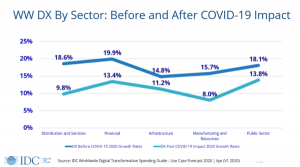“Click”
 Did you hear that? That’s the sound of a switch turning on as PR professionals realize they can make revenue gravy. What’s PR revenue gravy? Here’s my perspective.
Did you hear that? That’s the sound of a switch turning on as PR professionals realize they can make revenue gravy. What’s PR revenue gravy? Here’s my perspective.
First, understand PR is an integral part of marketing, not an offshoot. As a C-level executive with 30 years of marketing and sales experience, I can tell you unequivocally, everything revolves around Revenue Marketing™ i.e., marketing’s ability to drive revenue. The transformation of marketing from cost center to revenue center is happening because of technologies like marketing automation that track automatic responses to a prospect’s online behavior. Tracking behaviors creates a closed-loop reporting system between marketing and sales. The power to measure digital behavior enables PR to track lead sources back to specific campaigns, just like all other marketing programs.
Inherent in this approach is the ongoing digital dialog marketing orchestrates resulting in a “prospect conversion” – completing a form and becoming a name in the database for future marketing, completing a form and asking for more information, a piece of content or a call. Every digital communication channel leveraged by PR (web, email, social, mobile, etc.) and all content (press releases, publicity placements, web copy, landing pages, emails, blogs, white papers, case studies, etc.) must be optimized for this activity. By optimizing, I mean inserting a unique tracking link within the content that identifies from where the lead originated. This identification empowers PR to create and executive campaigns that make revenue gravy.
Case Study Vignette #1: The Traditional Approach
The switch must be turned on at both the PR agency and customer site. Consider this example using two recent discussions – one with a digital PR agency where the switch had not clicked on, another with a customer making PR gravy. Many PR agencies have successfully made the transition from print to digital PR from a traditional definition of PR. Recently I met such a company at a conference in Atlanta, GA, and began chatting about the future of digital PR. As I was listening to what this agency was doing, it dawned on me they had the same traditional PR focus (outward communication and building awareness), but were just applying it in a different channel – digital. This company was uneducated about how to make PR revenue gravy and consequently, was missing an incredible opportunity to create leads for clients as part of their PR efforts. Why? Because, like most PR people they were not wired to think about direct revenue results. They live in a world characterized by press releases, articles and media relations that are pushed through various digital and print channels designed to bring awareness, influence and engage key constituents in a market. They also have not kept up with technology – especially marketing automation – and don’t understand the possibilities they might create for clients. For example, in 2012 as I was working with a global software company who underwent a major rebranding and as they re-launched the brand, had no links for name capture or further communication or interest in any of the programs around the re-launch. What a waste.
Case Study Vignette #2: PR with Revenue Marketing
Compare this to a recent conversation with a savvy PR professional working in a global software and services organization. For him, PR was all the traditional elements plus a lead conversion channel. He worked closely with his company’s demand generation team to treat PR as another channel for leads. Every piece of content that the PR department proactively pushed out to the public, i.e. press releases, bylined articles, web copy, etc. was optimized for lead conversion. The result? This PR professional tracks all leads created as a result of PR programs and tracks them as a “PR lead source” from inception to close. He is making PR gravy.
In addition, this brilliant PR professional used demand generation to push his own publishing agenda. By using the technology backbone of his demand generation team, he created a series of small case studies that he placed in the market through email/social, which gained media attention. Rather than reacting, i.e. waiting for media to call him and ask for something based on their publishing agenda, he proactively used demand generation programs to entice media to use his publishing agenda. And, this program was optimized for making PR gravy.
Conclusion
I’m not saying PR should change its focus – we need the communication, awareness, and brand building PR brings. I am saying both PR agencies and PR professionals within companies should consider the big picture with all these moving parts and learn how to optimize PR for lead conversion. The push for all parts of marketing to show tangible ROI is here to stay. PR professionals have a huge opportunity to produce thick PR revenue gravy and demonstrate marketing ROI.
Does PR represent a “lead source” in your company? If so, I’d love to hear about it!
Business Articles | Business 2 Community
(337)







